Born at Fordwich in Ontario in 1876 He Studied Art in Toronto

Gazing north on Academy Avenue from s off Queen Street West on June 23, 1939. The Boer War monument is visible. The monument in the foreground is to Sir Adam Brook. Toronto Archives Fonds 1231, Fl1231, It1983.
The Boer War in South Africa commenced in 1899 and ended in 1902. Information technology was the last of the great royal wars fought by the British Empire. Between 6000 and 8000 Canadians volunteered to fight for Great Great britain against the Afrikaners, who were settlers of Dutch heritage. The state of war was mainly fought against two Boer republics—the Orange Free Land and the Transvaal Republic. Nigh 90 Canadians were killed in combat and approximately 180 died of disease.
To honour those who had perished, Toronto officials chose Walter Allward to design a memorial. He was one of Canada'due south well-nigh prominent sculptors. Born in Toronto on November 18, 1876, as a boy of 14, he worked with his father, who was a carpenter. Walter Allward attended Central Technical School and in Toronto studied nether well-known Canadian sculptors William Cruikshank and Emmanuel Hahn. He later studied in London and Paris. Returning home, he apprenticed with the architectural firm of Gibson and Simpson. While in their employment, he worked at the Don Valley Brick Works, where he modelled architectural ornaments. His first important commission was in 1895, to design a figure of "Victory" on a memorial to commemorate the Northwest Rebellion. The monument was located on the southeast corner of the grounds at Queen's Park and tin can withal be seen today.
In the first decade of the 20th century, mature chestnut trees flanked Academy Avenue, the wide roadway that led to Queen's Park. Walter Allward's South African monument was located at the south end of artery, which terminated at Queen Street. It was not extended further due south until the 1930s. When the monument was dedicated in 1910, Sir John French officiated. He unveiled a monument that possessed a granite cavalcade, at its base three figures cast in bronze. Two them were Canadian soldiers and the tertiary was a symbolic representation of Female parent Britain. At the top of the monument was a winged effigy holding a gilt crown. Crowds lined University Avenue for the occasion. On the east side of the artery, a short distance northward, was the Toronto Armouries, imposing a military presence at the scene. The armouries accept since been demolished.
Allward was later to pattern the great memorial at Vimy Ridge to commemorate the Starting time World War battle of Apr 1917, in northern France. The monument was dedicated in July 1936 by Rex Edward VIII.
![unveiling by Sir. John French f1568_it0526[1] unveiling by Sir. John French f1568_it0526[1]](https://tayloronhistory.com/wp-content/uploads/2015/05/unveiling-by-sir-john-french-f1568_it05261_thumb.jpg)
Unveiling of the Boer War Monument past Sir John French in 1910, Osgoode Hall in the groundwork, Fl 1568, It.0526
![1910--f1257_s1057_it0191[1] 1910--f1257_s1057_it0191[1]](https://tayloronhistory.com/wp-content/uploads/2015/05/1910-f1257_s1057_it01911_thumb.jpg)
The monument c. 1930, the Canada Life Building on the left and the Toronto Armouries in the altitude of the right. Toronto Archives, Fl 1257, S.105, It 0191
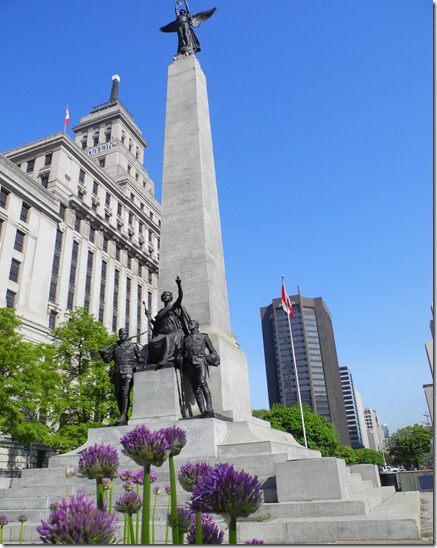
Walter Allwards's Southward African (Boer War) Memorial in 2012, at University and Queen Streets.
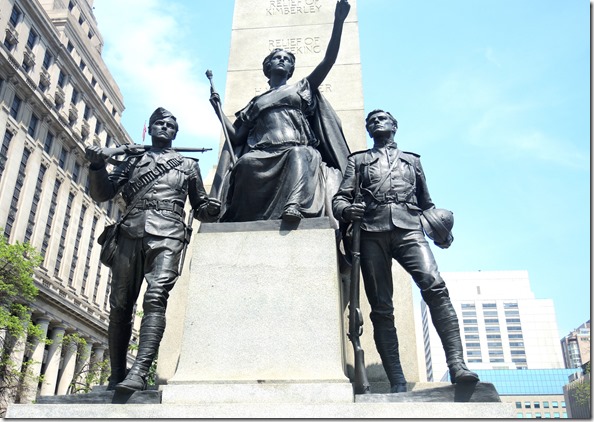
Allward's iii bronze figures at the base of operations of the granite monument. The names of the battles in the Boer State of war are carved into the granite column.
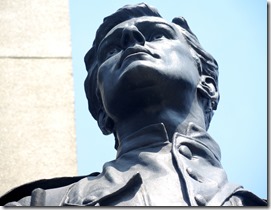
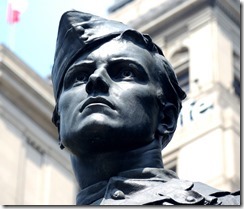
The earnest faces of the soldiers at the base of operations of the monument.
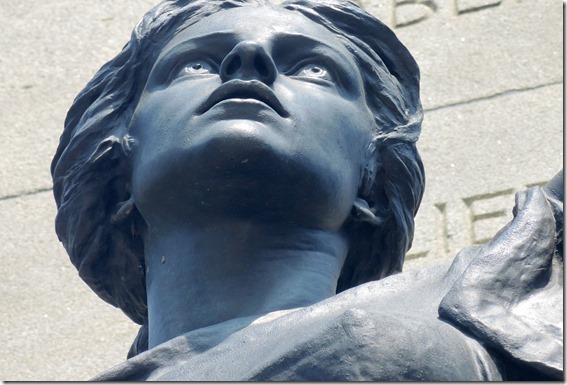
The bronze effigy representing Female parent Britain.
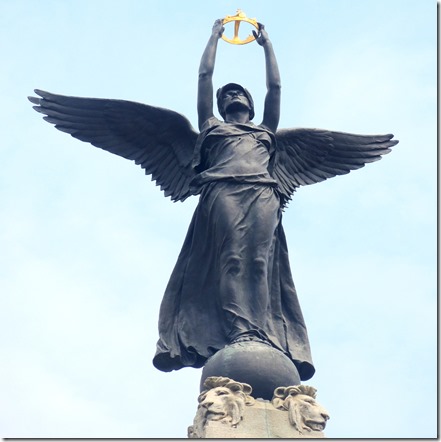
Winged figure property a golden crown, at the pinnacle of the granite cavalcade.
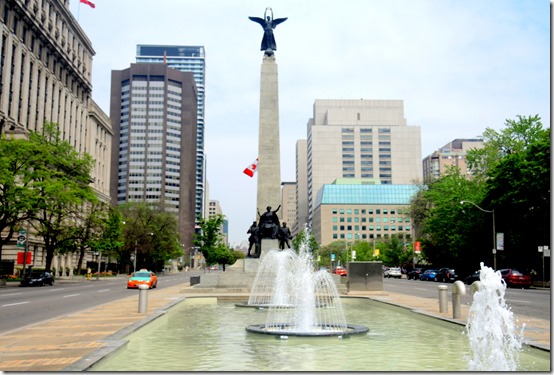
The Boer War monument on University Avenue on May eighteen, 2015.
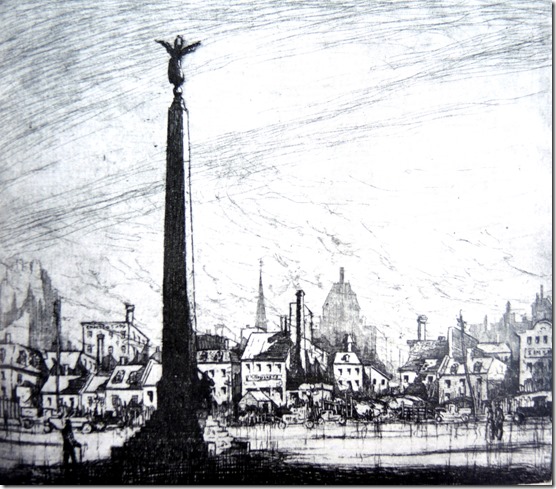
Gazing south from the Boer War monument on University Avenue in 1931. In that year, University Avenue terminated at Queen Street. The houses in the sketch, on the s side of Queen Street, were expropriated to extend the avenue further s. The Royal York Hotel is visible in the groundwork. Sketch from the Market place Gallery, Toronto.
To view the Abode Page for this blog: https://tayloronhistory.com/
To view previous blogs almost pic houses of Toronto—historic and modern
http://tayloronhistory.wordpress.com/2013/10/09/links-to-toronto-old-moving picture-housestayloronhistory-com/
Recent publication entitled "Toronto's Theatres and the Gilt Age of the Silvery Screen," past the author of this blog. The publication explores 50 of Toronto's old theatres and contains over 80 archival photographs of the facades, marquees and interiors of the theatres. It relates anecdotes and stories of the author and others who experienced these grand old film houses.
![cid_E474E4F9-11FC-42C9-AAAD-1B66D852[2] cid_E474E4F9-11FC-42C9-AAAD-1B66D852[2]](https://tayloronhistory.com/wp-content/uploads/2015/05/cid_e474e4f9-11fc-42c9-aaad-1b66d8522_thumb11.jpg)
To place an gild for this book:
https://www.historypress.net/catalogue/bookstore/books/Toronto-Theatres-and-the-Golden-Age-of-the-Silver-Screen/9781626194502 .
Book also available in Chapter/Indigo, the Bell Lightbox Book Store and by phoning University of Toronto Press, Distribution: 416-667-7791
Theatres Included in the Book:
Chapter One – The Early Years—Nickelodeons and the Starting time Theatres in Toronto
Theatorium (Red Mill) Theatre—Toronto's Get-go Movie Experience and Start Permanent Movie theater, Auditorium (Avenue, PIckford), Colonial Theatre (the Bay), the Photodrome, Revue Theatre, Cinema (Royal George), Large Nickel (National, Rio), Madison Theatre (Midtown, Capri, Eden, Bloor Picture palace, Bloor Street Hot Docs), Theatre Without a Name (Pastime, Prince Edward, Fox)
Chapter Two – The Swell Movie Palaces – The Stop of the Nickelodeons
Loew'southward Yonge Street (Elgin/Winter Garden), Shea'southward Hippodrome, The Allen (Tivoli), Pantages (Imperial, Majestic Six, Ed Mirvish), Loew's Uptown
Chapter Three – Smaller Theatres in the pre-1920s and 1920s
Oakwood, Broadway, Carlton on Parliament Street, Victory on Yonge Street (Embassy, Astor, Showcase, Federal, New Yorker, Panasonic), Allan'southward Danforth (Century, Titania, Music Hall), Parkdale, Alhambra (Baronet, Eve), St. Clair, Standard (Strand, Victory, Golden Harvest), Palace, Bedford (Park), Hudson (Mount Pleasant), Belsize (Crest, Regent), Runnymede
Chapter Four – Theatres During the 1930s, the Great Depression
Grant , Hollywood, Oriole (Cinema, International Cinema), Eglinton, Casino, Radio City, Paramount, Scarboro, Paradise (Eve'south Paradise), Country (Bloordale), Colony, Bellevue
Source: https://tayloronhistory.com/2015/05/26/torontos-boer-war-monument/
0 Response to "Born at Fordwich in Ontario in 1876 He Studied Art in Toronto"
ارسال یک نظر